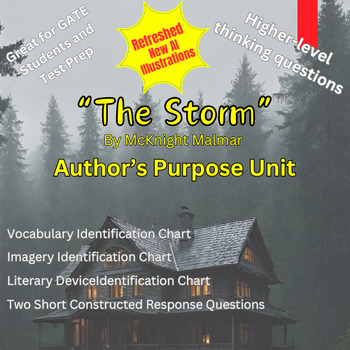The Storm by McKnight Malmar Author's Purpose Unit
Karen Rohach - Author's Purpose Expert
86 Followers
Grade Levels
7th - 10th
Subjects
Resource Type
Standards
CCSSRL.9-10.1
CCSSRL.9-10.2
CCSSRL.9-10.3
CCSSRL.9-10.4
CCSSL.9-10.4a
Formats Included
- PDF
Pages
40 pages
Karen Rohach - Author's Purpose Expert
86 Followers
What educators are saying
My students enjoyed the activity I put together with this resource. It helped them understand the story better.
Description
The unit contains various activities which require students to analyze the story, identify literary devices and determine why the author used them. It comes with a suggested lesson plan for the order of activities. The vocabulary chart uses context clues, the imagery and literary device charts ask students to find examples, and the higher-level thinking questions have students look closely at the author's words to determine his meaning. It also has two short constructed response questions on irony and change of connotation. Answers are provided for all activities.
Total Pages
40 pages
Answer Key
Included
Teaching Duration
N/A
Report this resource to TPT
Reported resources will be reviewed by our team. Report this resource to let us know if this resource violates TPT’s content guidelines.
Standards
to see state-specific standards (only available in the US).
CCSSRL.9-10.1
Cite strong and thorough textual evidence to support analysis of what the text says explicitly as well as inferences drawn from the text.
CCSSRL.9-10.2
Determine a theme or central idea of a text and analyze in detail its development over the course of the text, including how it emerges and is shaped and refined by specific details; provide an objective summary of the text.
CCSSRL.9-10.3
Analyze how complex characters (e.g., those with multiple or conflicting motivations) develop over the course of a text, interact with other characters, and advance the plot or develop the theme.
CCSSRL.9-10.4
Determine the meaning of words and phrases as they are used in the text, including figurative and connotative meanings; analyze the cumulative impact of specific word choices on meaning and tone (e.g., how the language evokes a sense of time and place; how it sets a formal or informal tone).
CCSSL.9-10.4a
Use context (e.g., the overall meaning of a sentence, paragraph, or text; a word’s position or function in a sentence) as a clue to the meaning of a word or phrase.


